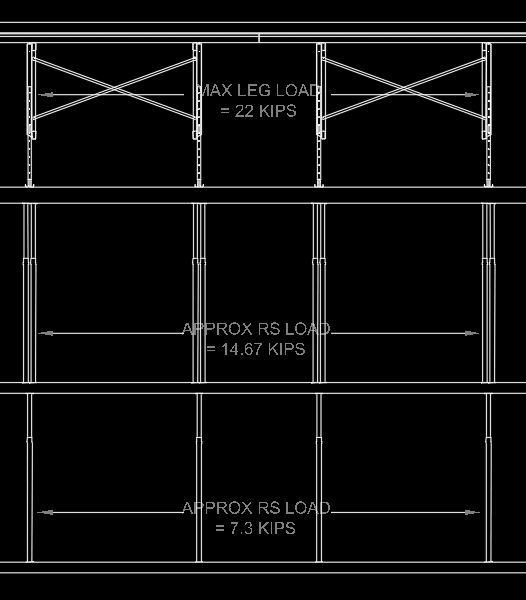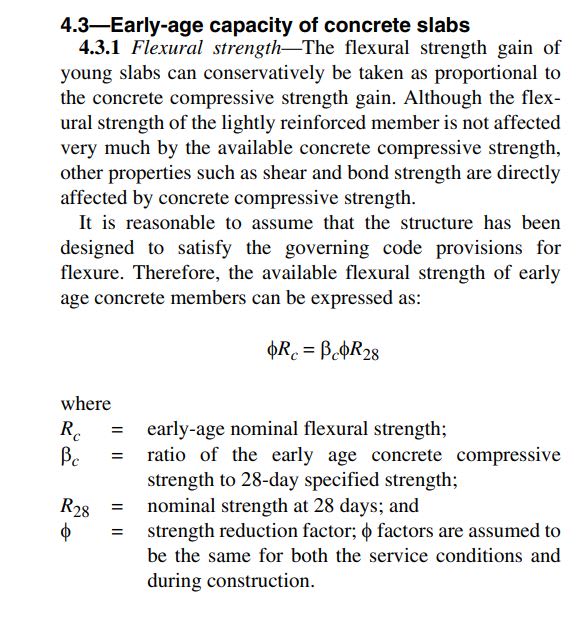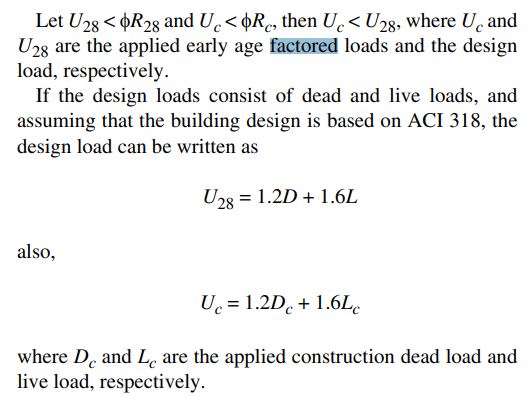Good morning, I've been a follower of pretty much every thread regarding shoring/ reshoring. I Hope @EngineerMary is still around.
I got a couple question regarding reshoring.
1. I am new to reshoring, so in my company I am gathering old designs to use somehow as templates. I got the situation, in which I found a couple designs in which no load from the reshores is considered, but when I do consider the loads from the reshores there is a different animal, and the slab "fails". See below
. Design load all floors: DL: 8" Slab (100 psf), LL: 40 psf, additional DL: 10 psf, Factored design capacity: 196 psf.
. Construction loads: DL: 8" Slab (100 psf), LL: 50psf, DL (forms & Shores): 10 psf, DL (reshores) 5 psf, Factored construction loads (during pour): 212 psf.
So, to the left, is my design, considering the weigh of the reshores (5 psf) being added to the slabs 3 & 2, right, is the design without said weight.

As you can see, in the left slab # 2 is overloaded, which suggest another level of reshoring needed, on the right, slab is OK.
which brings me to the second question:
2. As a first approach, I'd use the unfactored loads 160 (Slab + LL + DL (Construction)) / 50 (LL + DL (Design)) = 3.2 interconnected slabs ~ 4. But if I use factored loads, 212 (Construction, factored) / 76 (Design, LL + DL, factored) = 2.78 ~ 3 interconnected slabs. Which approach is correct, and why??
3. Third question, when having tables, or a shoring such that it can not be considered uniformly distributed, SP-4 (14), Formwork for concrete, states in 6.7.3: "... An approximate solution may be obtained by finding max. moments and shears, and determining and equivalent uniform load..." is this, finding moments and shears as it was a two way slab, taking the reshores as supports? or similarly, distributing the load between interconnected slabs, and getting that equivalent uniform load taking columns/ walls as supports?

Thanks all in advance.
I got a couple question regarding reshoring.
1. I am new to reshoring, so in my company I am gathering old designs to use somehow as templates. I got the situation, in which I found a couple designs in which no load from the reshores is considered, but when I do consider the loads from the reshores there is a different animal, and the slab "fails". See below
. Design load all floors: DL: 8" Slab (100 psf), LL: 40 psf, additional DL: 10 psf, Factored design capacity: 196 psf.
. Construction loads: DL: 8" Slab (100 psf), LL: 50psf, DL (forms & Shores): 10 psf, DL (reshores) 5 psf, Factored construction loads (during pour): 212 psf.
So, to the left, is my design, considering the weigh of the reshores (5 psf) being added to the slabs 3 & 2, right, is the design without said weight.

As you can see, in the left slab # 2 is overloaded, which suggest another level of reshoring needed, on the right, slab is OK.
which brings me to the second question:
2. As a first approach, I'd use the unfactored loads 160 (Slab + LL + DL (Construction)) / 50 (LL + DL (Design)) = 3.2 interconnected slabs ~ 4. But if I use factored loads, 212 (Construction, factored) / 76 (Design, LL + DL, factored) = 2.78 ~ 3 interconnected slabs. Which approach is correct, and why??
3. Third question, when having tables, or a shoring such that it can not be considered uniformly distributed, SP-4 (14), Formwork for concrete, states in 6.7.3: "... An approximate solution may be obtained by finding max. moments and shears, and determining and equivalent uniform load..." is this, finding moments and shears as it was a two way slab, taking the reshores as supports? or similarly, distributing the load between interconnected slabs, and getting that equivalent uniform load taking columns/ walls as supports?

Thanks all in advance.


